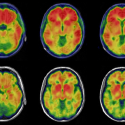Study: Division I college athletes outpace student peers in mental health
Competing at the highest level in college sports while managing a full class schedule and generally navigating a new life as an adult would seem fraught with an unusual amount of stress and anxiety.
That may be the case, but a new study of students at the University of Wisconsin–Madison finds the university’s Division I athletes in enviable psychological shape — reporting a level of mental well-being far above their non-athlete classmates.
That’s a bit of a surprise to Traci Snedden, the UW–Madison professor of nursing who led the study, which was published Wednesday by the American Journal of Health Promotion. Previous research examining smaller groups of international, elite or college athletes had offered mixed results on athlete mental health.
“There’s so much happening with these student-athletes amidst their athletic involvement, travel, performance pressure, academic responsibilities, and some of them reaching to go pro,” says Snedden. “It makes you wonder, what’s going on with their mental health? How are they balancing all of this?”
In 2016, Snedden and her collaborators in the UW–Madison School of Medicine and Public Health recruited 842 athletes from UW–Madison’s NCAA Division I sports teams and 1,322 undergraduates who weren’t members of a Division I team. Each completed a standardized survey of the quality of their physical and mental health called the VR-12.
“Here you have a large group of people all on the same academic calendar, in the same degree programs, in the same wonderful climate, and we gave them the same measure at the same time of year,” says Snedden. “However, when we compared the non-Division-I undergrads to the Division I student-athletes, the athletes’ results reflected more positive overall mental health.”
The Division I athletes posted an average VR-12 mental health score of 55.46. Their scores were substantially higher than any of the four levels of physical activity the undergraduate students self-selected: club athletes (45.74), intramural sports players (45.46), regular exercisers (44.04) and physically inactive (41.39).
A difference of 7.9 points on the survey’s mental health scale is considered clinically significant.
“That’s a difference in score that should prompt further attention from a health care professional,” Snedden says. “We see a large difference here, even while the two groups — the Division I student-athletes and the non-Division-I undergrads — have roughly the same results on the physical component of the survey.”
The non-athlete students’ mental component scores were also below the survey’s population norms for males and females ages 18 to 34. Snedden would like to focus future research on just what might be contributing to these results. But, relative to the high-scoring Division I athletes, Snedden proposed some potential difference-makers.
“Just think about the difference in resources,” she says. “The DI athletes have resources to support their academic success readily available — tutors and advisors, study hours. They have healthy food available. They have athletic trainers and team physicians if they get an injury, a sore throat or a fever.”
More typical undergrads may not have health insurance coverage in Wisconsin or the campus area.
“They might not have experience with or are unaware of (UW–Madison’s) University Health Services, don’t know how to navigate health care needs, or don’t feel they have time to take care of an illness,” Snedden says.
The resources extend specifically to mental health, as well.
“Division I athletic programs have psychologists, psychiatrists and mental health advisors available to them to support their athletes’ general mental health needs, and keep their head in the game,” Snedden says. “Similarly, UW–Madison is doing a great job offering mental health services to all of our students (athletes and non-athletes), recently launching a number of important initiatives and supporting a very active campus-based NAMI (National Alliance on Mental Illness) group. But our undergrads are probably, like many people, still struggling with ‘What do I do? Nobody cares. Can I tell anybody?’”
The disparity in reported mental well-being is enough to suggest that extending similar and additional resources to undergraduates in general could be helpful. And the dwindling mental health scores as physical activity drops among undergraduate students leads Snedden and her collaborators to strongly conclude that campus environments that promote physical activity are also likely to raise overall mental health.
This research was supported by grants from the National Institutes of Health (R01HD071089 and R25GMO83252).



